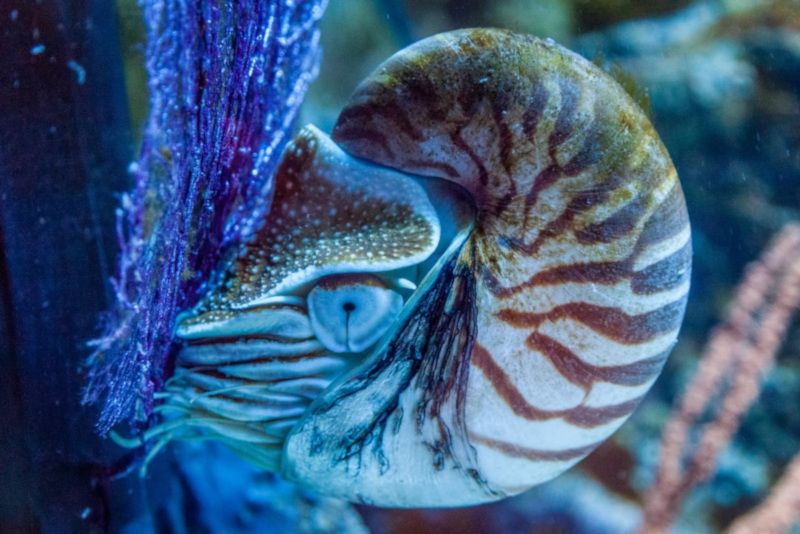
Palau Nautilus Facts
- Perhaps most notably, the term of Palau Nautilus serves as the only generally recognized common name for a truly remarkable mollusk. Furthermore, this supremely impressive marine creature also bears a somewhat cumbersome scientific name.
- More precisely, though, this hard to pronounce term consists of the name Nautilus belauensis. However, regardless of which name one uses for the lovely creature, the animal represents a truly impressive and beautiful ocean-dwelling animal species.
- In addition, as a form of nautilus, this visually remarkable animal also constitutes one of the lesser-known types of cephalopod inhabiting the oceans. Further, the common name of this fascinating Mollusk also directly derives from its native habitat range.
- Unfortunately, at present, only seven recognized species of nautilus still exist. Further, this lamentable fact holds true throughout the entirely of the oceans of the world. Quite sadly, two other species once existed, but now appear to be extinct.
- Plus, for the moment at least, the known population of the stunning Palau Nautilus appears to be relatively stable. As a result, the IUCN does not yet list the animal. Such a status would appear on the organization’s Red List of Threatened Species.
- Nonetheless, it may be considered to be at at least some risk, for several reasons. First of all, one of these dangers continues to consist of the problem posed by habitat loss. Not surprisingly, this hazard arises through the actions of man.
- However, yet another peril it must deal with remains. That particular danger consists of accidental encounters with humans throughout its territory. But, the greatest threat to its existence, like many species, appears to be ongoing climate change.
Related Articles
Palau Nautilus Physical Description
First of all, it must be noted that none of the currently known forms of amazing nautilus attain a great size. That’s despite the fact that Nature has been working on these marvelous creatures for more than 500 million years. Sometimes less really counts as more.
However, among them, the gorgeous Palau Nautilus stands out from the crowd. It ranks as the greatest of them, in terms of overall physical size. That statement holds true due to the fact that its shell attain a maximum measured diameter of approximately 10 in (25 cm).
Also, much like many other species around the world, this remarkable animal displays a mild degree of the trait of sexual dimorphism. In the case of this particular invertebrate, this trait displays itself in the fact that males average slightly larger than females.
Obviously, the shell grows as the creature within it does. In addition to this, as the creature and its shell mature, this develops an easily distinguishable longitudinally crenulated shape. Further, when viewed from one side, that same shell possesses a roughly triangular shape.
Furthermore, much like many of its close relatives, it possesses a striking appearance. In point of fact, the patterning of color of the gorgeous Palau Nautilus makes this specific animal easily recognizable. This primarily consists of brown and reddish stripes.
In addition, these highly visible and distinctive markings cover a large portion of the body. These extend from the inner shell to the outer portions of it. Finally, in most individuals, the thickness of the shell also tends to be slightly greater than related species.
- Kingdom: Animalia
- Phylum: Mollusca
- Class: Cephalopoda
- Order: Nautilida
- Family: Nautilidae
- Genus: Nautilus
- Species: N. balaeuensis
Palau Nautilus Distribution, Habitat, and Ecology
Quite unfortunately, the remarkable species known as the Palau Nautilus has another amazing trait. It appears to inhabit an extremely restricted habitat range. That holds true because it only lives in a tiny portion of the western sections of the Pacific Ocean.
More specifically, however, that tiny zone of habitation consists of a comparatively remote region. The range includes the waters around the roughly 340 islands comprising the country of Palau, which in turn forms part of the Western Carolines.
Furthermore, even within this extremely limited area, the fascinating animal appears to be highly selective of where it chooses to live. That occurs due to the fact that all observes specimens appeared at depths ranging from 312 – 1,654 ft (95 – 504 m).
Even more specifically, though, the greatest majority of individuals actually occurred at depths measuring between 492 -984 ft (150 – 300 m). Those individuals appearing at depths outside of this smaller range actually comprise only a small fraction of its population.
In addition, the specific requirements of the awesome Palau Nautilus do not end there. That happens given the fact that it also only appears in waters possessing a specific range of temperatures. That range happens to be between 49 – 62 F (9.4 – 16.6 C).
However, an ongoing, and sometimes complicated, mystery surrounds this aspect of its life. Despite intensive research, the precise reason for the need or preference for such a precise range of water temperatures currently remains undetermined by researchers.
In addition, and also like its relatives, it mainly feeds as an opportunistic scavenger. In this, it typically consumes a comparatively wide variety of dead species. But, these mostly include fish and small crustaceans. Its own predators mainly include octopi and sharks.
Species Sharing Its Range
Check out our other articles on Earth’s Many Magnificent Marsupials, Indian Bullfrog, Christmas Island, Naked Man Orchid, Tiger Rattlesnake, Saint Francis’ Satyr Butterfly, Eurasian Brown Bear
